1.语言学导论
- 格式:docx
- 大小:26.63 KB
- 文档页数:7
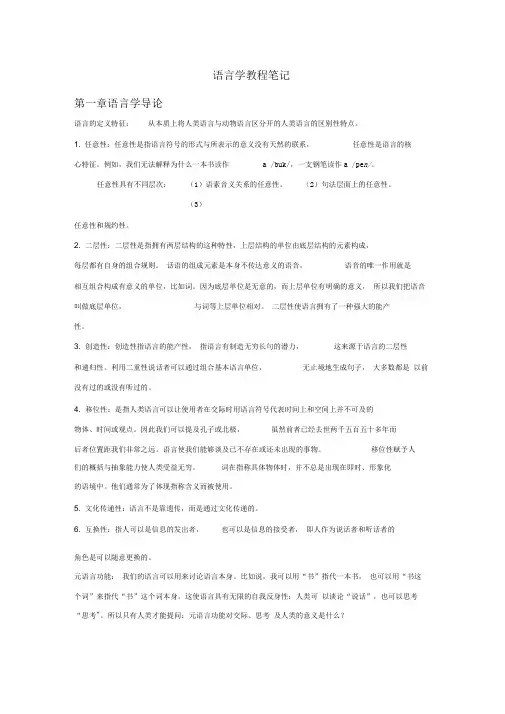
语言学教程笔记第一章语言学导论语言的定义特征:从本质上将人类语言与动物语言区分开的人类语言的区别性特点。
1. 任意性:任意性是指语言符号的形式与所表示的意义没有天然的联系,任意性是语言的核心特征。
例如,我们无法解释为什么一本书读作 a /buk/,一支钢笔读作a /pe n/。
任意性具有不同层次:(1)语素音义关系的任意性。
(2)句法层面上的任意性。
(3)任意性和规约性。
2. 二层性:二层性是指拥有两层结构的这种特性,上层结构的单位由底层结构的元素构成,每层都有自身的组合规则。
话语的组成元素是本身不传达意义的语音,语音的唯一作用就是相互组合构成有意义的单位,比如词。
因为底层单位是无意的,而上层单位有明确的意义,所以我们把语音叫做底层单位,与词等上层单位相对。
二层性使语言拥有了一种强大的能产性。
3. 创造性:创造性指语言的能产性,指语言有制造无穷长句的潜力,这来源于语言的二层性和递归性。
利用二重性说话者可以通过组合基本语言单位,无止境地生成句子,大多数都是以前没有过的或没有听过的。
4. 移位性:是指人类语言可以让使用者在交际时用语言符号代表时间上和空间上并不可及的物体、时间或观点。
因此我们可以提及孔子或北极,虽然前者已经去世两千五百五十多年而后者位置距我们非常之远。
语言使我们能够谈及已不存在或还未出现的事物。
移位性赋予人们的概括与抽象能力使人类受益无穷。
词在指称具体物体时,并不总是出现在即时、形象化的语境中。
他们通常为了体现指称含义而被使用。
5. 文化传递性:语言不是靠遗传,而是通过文化传递的。
6. 互换性:指人可以是信息的发出者,也可以是信息的接受者,即人作为说话者和听话者的角色是可以随意更换的。
元语言功能:我们的语言可以用来讨论语言本身。
比如说,我可以用“书”指代一本书,也可以用“书这个词”来指代“书”这个词本身。
这使语言具有无限的自我反身性:人类可以谈论“说话”,也可以思考“思考"。

外国语言文学专业课程总结模板语言学导论在外国语言文学专业的学习过程中,课程总结是非常重要的一环。
本文将以语言学导论为例,通过总结模板的方式来帮助学生整理知识并提高写作水平。
一、课程概述语言学导论是外国语言文学专业的基础课程之一,旨在帮助学生建立对语言学基本理论的认知和理解。
该课程的学习目标包括了解语言学的基本概念、掌握语言学的研究方法和理论框架,并能够运用语言学知识进行语言分析和研究。
二、课程收获通过学习语言学导论课程,我取得了以下几方面的收获:1. 理论基础:在语言学导论课程中,我系统学习了语言学的基础理论,如音系学、形态学、句法学、语义学等。
这些理论帮助我深入了解语言的结构和规则,提升了我的语言分析和解读能力。
2. 方法论意识:课程中,我学习了语言学的研究方法,如实证研究、对比研究、历史语言学等。
这些方法论意识的培养让我能够运用科学的方法进行语言学的研究和分析,从而更好地理解语言的本质和变化规律。
3. 学术论文写作:语言学导论课程为我提供了大量的写作实践机会。
在撰写学术论文的过程中,我学会了正确引用和参考文献的使用,提高了写作的规范性和准确性。
这对于未来进行学术研究和写作毕业论文有着积极的促进作用。
三、课程亮点语言学导论课程的亮点主要体现在以下几个方面:1. 经典案例:课程中教授多次引用经典案例,如乔姆斯基的生成语法理论、萨帕尔的语用学理论等。
通过深入解读和分析这些案例,我在理解和掌握语言学理论上收获颇丰。
2. 实证研究项目:课程中设置了语言学实证研究项目,要求学生运用所学的理论和方法进行课题研究。
这个环节帮助我将理论知识与实际问题相结合,并提高了自己的实际操作能力。
3. 互动教学:语言学导论课程注重学生的互动参与,教授常常组织小组讨论和演示,学生可以在小组内互相交流和分享心得。
这样的教学形式促进了学生们之间的互动和合作,提升了课程的学习效果。
四、个人感悟通过语言学导论课程的学习,我逐渐认识到语言是人类交流和思维的重要工具,语言学的研究对于了解人类社会和文化具有重要意义。

语言导论试题及答案一、单选题(每题2分,共20分)1. 语言导论中,语言的最小意义单位是:A. 音素B. 词C. 短语D. 句子答案:A2. 下列哪项不是语言的社会功能?A. 信息传递B. 文化传承C. 情感表达D. 个人娱乐答案:D3. 语言的任意性是指:A. 语言符号与其所指对象之间没有必然联系B. 语言符号与其所指对象之间有必然联系C. 语言符号与其所指对象之间有逻辑关系D. 语言符号与其所指对象之间有物理关系答案:A4. 语言的双重性是指:A. 语言的任意性和线性B. 语言的任意性和系统性C. 语言的线性和社会性D. 语言的系统性和社会性答案:A5. 语言的线性是指:A. 语言符号的排列顺序B. 语言符号的排列顺序和组合方式C. 语言符号的排列顺序和意义D. 语言符号的排列顺序和语法规则答案:B6. 语言的系统性是指:A. 语言符号的任意性B. 语言符号的线性C. 语言符号的组合方式D. 语言符号的内部结构和规则答案:D7. 语言的变异性是指:A. 语言随时间而变化B. 语言随地域而变化C. 语言随社会群体而变化D. 所有上述情况答案:D8. 语言的交际功能包括:A. 叙述B. 描述C. 命令D. 所有上述情况答案:D9. 语言的表达功能包括:A. 情感表达B. 思想表达C. 意图表达D. 所有上述情况答案:D10. 语言的元语言功能是指:A. 描述语言本身B. 描述语言的规则C. 描述语言的使用D. 所有上述情况答案:D二、简答题(每题5分,共20分)1. 简述语言的创造性。
答案:语言的创造性是指说话者能够根据需要创造新的表达方式来描述新的事物或表达新的思想,而不需要改变语言的基本结构。
2. 描述语言的符号性。
答案:语言的符号性是指语言中的符号(如音素、词、短语等)与其所指对象之间没有直接的物理或自然联系,而是通过社会约定俗成的方式建立起的联系。
3. 举例说明语言的任意性。
答案:语言的任意性可以通过“猫”这个词来说明。

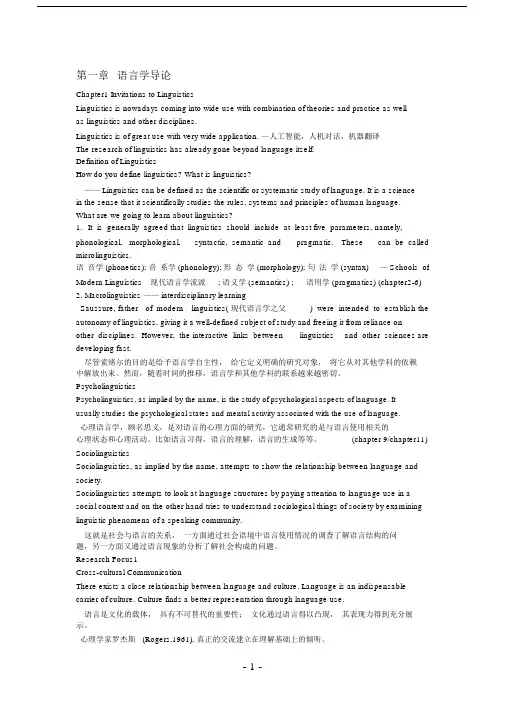
第一章语言学导论Chapter1 Invitations to LinguisticsLinguistics is nowadays coming into wide use with combination of theories and practice as wellas linguistics and other disciplines.Linguistics is of great use with very wide application. —人工智能,人机对话,机器翻译The research of linguistics has already gone beyond language itself.Definition of LinguisticsHow do you define linguistics? What is linguistics?—— Linguistics can be defined as the scientific or systematic study of language. It is a sciencein the sense that it scientifically studies the rules, systems and principles of human language.What are we going to learn about linguistics?1.It is generally agreed that linguistics should include at least five parameters, namely, phonological, morphological, syntactic, semantic and pragmatic. These can be called microlinguistics.语音学 (phonetics); 音系学 (phonology); 形态学 (morphology); 句法学 (syntax) — Schools of Modern Linguistics 现代语言学流派; 语义学 (semantics) ; 语用学 (pragmatics) (chapter2-6) 2. Macrolinguistics —— interdisciplinary learningSaussure, father of modern linguistics( 现代语言学之父) were intended to establish the autonomy of linguistics, giving it a well-defined subject of study and freeing it from reliance onother disciplines. However, the interactive links between linguistics and other sciences are developing fast.尽管索绪尔的目的是给予语言学自主性,给它定义明确的研究对象,将它从对其他学科的依赖中解放出来。

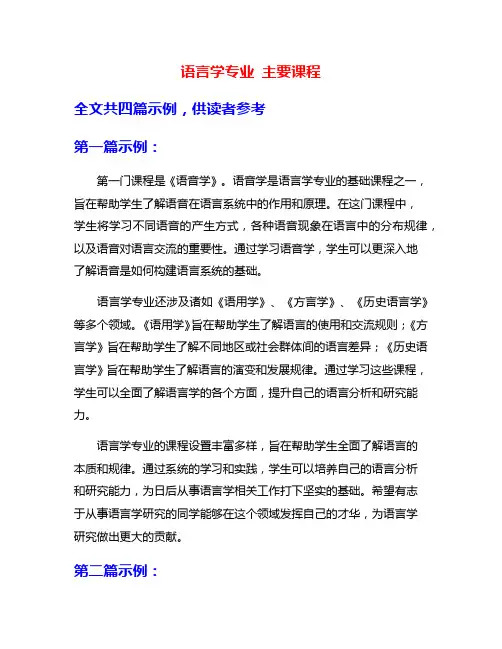
语言学专业主要课程全文共四篇示例,供读者参考第一篇示例:第一门课程是《语音学》。
语音学是语言学专业的基础课程之一,旨在帮助学生了解语音在语言系统中的作用和原理。
在这门课程中,学生将学习不同语音的产生方式,各种语音现象在语言中的分布规律,以及语音对语言交流的重要性。
通过学习语音学,学生可以更深入地了解语音是如何构建语言系统的基础。
语言学专业还涉及诸如《语用学》、《方言学》、《历史语言学》等多个领域。
《语用学》旨在帮助学生了解语言的使用和交流规则;《方言学》旨在帮助学生了解不同地区或社会群体间的语言差异;《历史语言学》旨在帮助学生了解语言的演变和发展规律。
通过学习这些课程,学生可以全面了解语言学的各个方面,提升自己的语言分析和研究能力。
语言学专业的课程设置丰富多样,旨在帮助学生全面了解语言的本质和规律。
通过系统的学习和实践,学生可以培养自己的语言分析和研究能力,为日后从事语言学相关工作打下坚实的基础。
希望有志于从事语言学研究的同学能够在这个领域发挥自己的才华,为语言学研究做出更大的贡献。
第二篇示例:语言学专业是人文学科中一门重要而且专业性强的学科,主要是研究人类语言的起源、发展、变化以及相关现象。
在语言学专业中,学生将学习到许多不同的课程,这些课程涵盖了语言学的不同领域,为他们提供了丰富的知识和技能。
以下是语言学专业的主要课程:一、基础课程1. 语言学引论:介绍语言学的基本概念、发展历史和主要研究领域,为后续课程打下基础。
2. 语音学:研究语音的产生、传播和感知,包括语音的发音方法、国际音标等内容。
3. 语法学:研究句子结构和规则,探讨语法的基本原理和分类。
4. 语义学:研究语言中词语和句子的意义,探讨逻辑、语义和语用之间的关系。
三、专业课程1. 语言学研究方法:介绍语言学研究的方法论和技术,培养学生的研究能力和创新意识。
2. 语言学理论:深入探讨现代语言学的主要理论,包括结构主义、生成文法、认知语言学等内容。
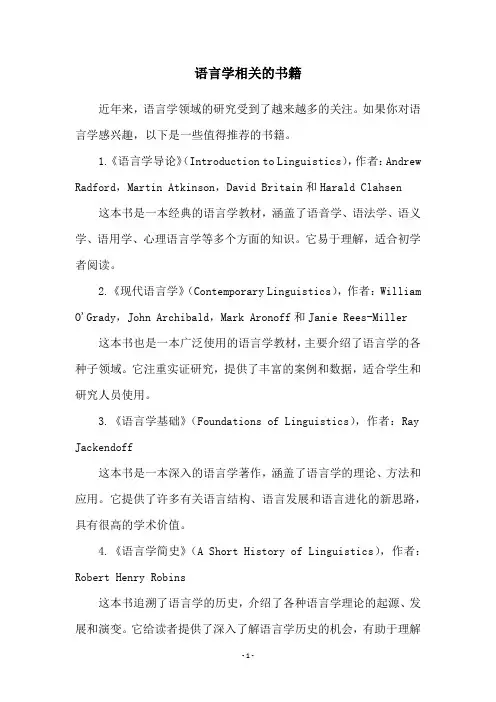
语言学相关的书籍近年来,语言学领域的研究受到了越来越多的关注。
如果你对语言学感兴趣,以下是一些值得推荐的书籍。
1.《语言学导论》(Introduction to Linguistics),作者:Andrew Radford,Martin Atkinson,David Britain和Harald Clahsen 这本书是一本经典的语言学教材,涵盖了语音学、语法学、语义学、语用学、心理语言学等多个方面的知识。
它易于理解,适合初学者阅读。
2.《现代语言学》(Contemporary Linguistics),作者:William O'Grady,John Archibald,Mark Aronoff和Janie Rees-Miller 这本书也是一本广泛使用的语言学教材,主要介绍了语言学的各种子领域。
它注重实证研究,提供了丰富的案例和数据,适合学生和研究人员使用。
3.《语言学基础》(Foundations of Linguistics),作者:Ray Jackendoff这本书是一本深入的语言学著作,涵盖了语言学的理论、方法和应用。
它提供了许多有关语言结构、语言发展和语言进化的新思路,具有很高的学术价值。
4.《语言学简史》(A Short History of Linguistics),作者:Robert Henry Robins这本书追溯了语言学的历史,介绍了各种语言学理论的起源、发展和演变。
它给读者提供了深入了解语言学历史的机会,有助于理解语言学的现状和未来。
5.《语言、文化和社会》(Language, Culture, and Society),作者:Christine Jourdan和Kevin Tuite这本书讨论了语言、文化和社会之间的相互关系。
它探讨了语言对文化和社会的影响,以及文化和社会对语言的影响。
它是一本全面而深入的语言学读物,适合对语言的文化和社会背景感兴趣的读者。
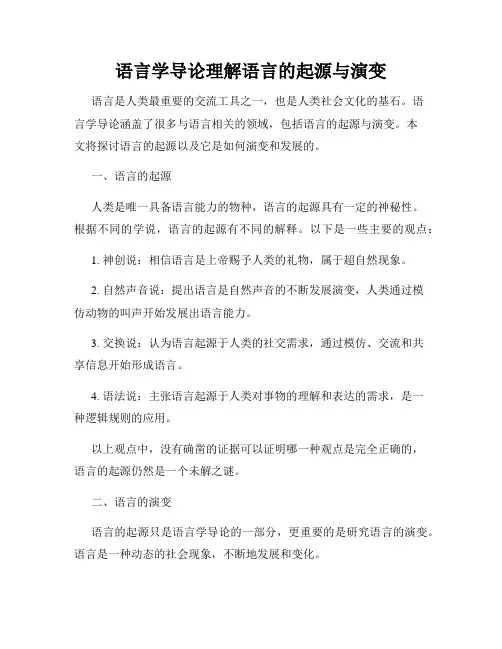
语言学导论理解语言的起源与演变语言是人类最重要的交流工具之一,也是人类社会文化的基石。
语言学导论涵盖了很多与语言相关的领域,包括语言的起源与演变。
本文将探讨语言的起源以及它是如何演变和发展的。
一、语言的起源人类是唯一具备语言能力的物种,语言的起源具有一定的神秘性。
根据不同的学说,语言的起源有不同的解释。
以下是一些主要的观点:1. 神创说:相信语言是上帝赐予人类的礼物,属于超自然现象。
2. 自然声音说:提出语言是自然声音的不断发展演变,人类通过模仿动物的叫声开始发展出语言能力。
3. 交换说:认为语言起源于人类的社交需求,通过模仿、交流和共享信息开始形成语言。
4. 语法说:主张语言起源于人类对事物的理解和表达的需求,是一种逻辑规则的应用。
以上观点中,没有确凿的证据可以证明哪一种观点是完全正确的,语言的起源仍然是一个未解之谜。
二、语言的演变语言的起源只是语言学导论的一部分,更重要的是研究语言的演变。
语言是一种动态的社会现象,不断地发展和变化。
1. 声音演化语言最早是通过声音来表达的,随着时间的推移,人们对声音的产生和感知逐渐了解。
从简单的声音演变成了更复杂的音节和词汇,形成了语言中的基本元素。
2. 语法和句法发展随着语言的发展,人们开始制定语法和句法规则,使语言更具结构和逻辑。
不同的语言有不同的语法规则,但都为有效地表达思想和信息提供了框架。
3. 词汇的演变语言的词汇是不断发展变化的。
新的词汇会随着时间的推移而出现,一些过时的词汇会逐渐被淘汰。
此外,语言也会通过借词、合成词和词义的扩展等方式不断地丰富和发展。
4. 方言和语族的形成语言随着地理和历史的影响而分化成多个方言和语族,最终演化成不同的语言。
语言的分化和融合反映了人类社会的多样性和交流的复杂性。
总结:语言学导论在理解语言的起源与演变方面做出了重要的贡献。
虽然语言的起源仍然是未知的谜团,但不同的学说提供了各自的观点和解释。
与此同时,语言的演变是一个复杂而丰富的过程,涉及声音、语法、词汇和方言等多个方面。
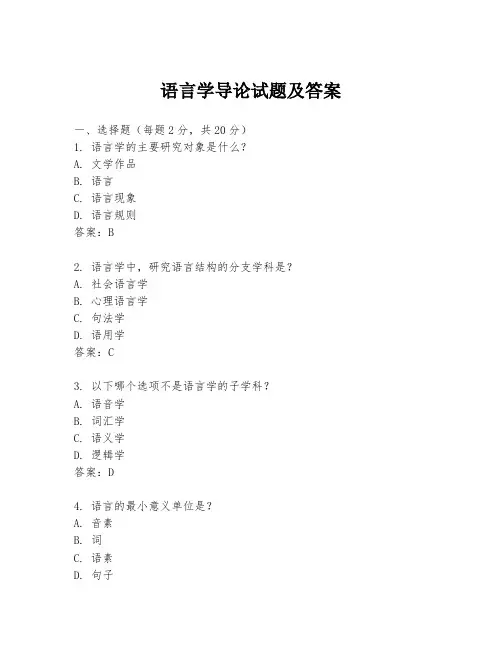
语言学导论试题及答案一、选择题(每题2分,共20分)1. 语言学的主要研究对象是什么?A. 文学作品B. 语言C. 语言现象D. 语言规则答案:B2. 语言学中,研究语言结构的分支学科是?A. 社会语言学B. 心理语言学C. 句法学D. 语用学答案:C3. 以下哪个选项不是语言学的子学科?A. 语音学B. 词汇学C. 语义学D. 逻辑学答案:D4. 语言的最小意义单位是?A. 音素B. 词C. 语素D. 句子答案:C5. 以下哪个术语是描述单词在特定语境中的意义?A. 语法意义B. 词义C. 语义D. 语用意义答案:D6. 语言的音素和字母之间的关系是?A. 一一对应B. 多对一C. 一对多D. 没有固定关系答案:D7. 以下哪个选项是描述语言随时间演变的学科?A. 社会语言学B. 历史语言学C. 心理语言学D. 神经语言学答案:B8. 语言的地域变体被称为?A. 语种B. 方言C. 语言D. 语言变体答案:B9. 以下哪个术语是描述语言的交际功能?A. 语言能力B. 语言表现C. 语言使用D. 语言结构答案:C10. 语言学中,研究语言在社会中的作用和影响的学科是?A. 社会语言学B. 心理语言学C. 神经语言学D. 历史语言学答案:A二、填空题(每题2分,共20分)1. 语言学的创始人是________。
答案:费迪南德·德·索绪尔2. 语言的四个基本功能包括表达、信息、社交和________。
答案:情感3. 语言的________性是指它能够传递新信息。
答案:创造性4. 语言的________性是指它能够传递旧信息。
答案:习惯性5. 语言学中,研究语言和思维关系的学科是________。
答案:心理语言学6. 语言的________性是指它能够跨越时间和空间进行交流。
答案:传递性7. 语言的________性是指它能够表达复杂的概念。
答案:表达性8. 语言学中,研究语言在大脑中如何被处理的学科是________。
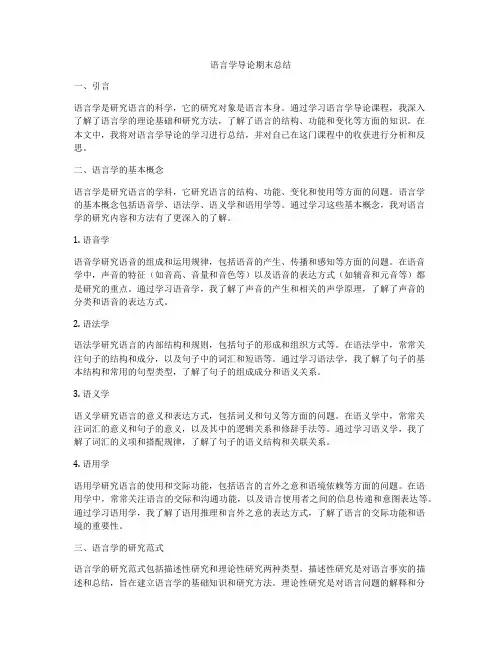
语言学导论期末总结一、引言语言学是研究语言的科学,它的研究对象是语言本身。
通过学习语言学导论课程,我深入了解了语言学的理论基础和研究方法,了解了语言的结构、功能和变化等方面的知识。
在本文中,我将对语言学导论的学习进行总结,并对自己在这门课程中的收获进行分析和反思。
二、语言学的基本概念语言学是研究语言的学科,它研究语言的结构、功能、变化和使用等方面的问题。
语言学的基本概念包括语音学、语法学、语义学和语用学等。
通过学习这些基本概念,我对语言学的研究内容和方法有了更深入的了解。
1. 语音学语音学研究语音的组成和运用规律,包括语音的产生、传播和感知等方面的问题。
在语音学中,声音的特征(如音高、音量和音色等)以及语音的表达方式(如辅音和元音等)都是研究的重点。
通过学习语音学,我了解了声音的产生和相关的声学原理,了解了声音的分类和语音的表达方式。
2. 语法学语法学研究语言的内部结构和规则,包括句子的形成和组织方式等。
在语法学中,常常关注句子的结构和成分,以及句子中的词汇和短语等。
通过学习语法学,我了解了句子的基本结构和常用的句型类型,了解了句子的组成成分和语义关系。
3. 语义学语义学研究语言的意义和表达方式,包括词义和句义等方面的问题。
在语义学中,常常关注词汇的意义和句子的意义,以及其中的逻辑关系和修辞手法等。
通过学习语义学,我了解了词汇的义项和搭配规律,了解了句子的语义结构和关联关系。
4. 语用学语用学研究语言的使用和交际功能,包括语言的言外之意和语境依赖等方面的问题。
在语用学中,常常关注语言的交际和沟通功能,以及语言使用者之间的信息传递和意图表达等。
通过学习语用学,我了解了语用推理和言外之意的表达方式,了解了语言的交际功能和语境的重要性。
三、语言学的研究范式语言学的研究范式包括描述性研究和理论性研究两种类型。
描述性研究是对语言事实的描述和总结,旨在建立语言学的基础知识和研究方法。
理论性研究是对语言问题的解释和分析,旨在建立语言学的理论体系和解释框架。
语言学教程(修订版) 练习参考答案修订版第一章语言学导论 1第二章语音 3第三章词汇 8第四章句法 11第五章语义 15第六章语言与思维 18第七章语言、文化与社会 20第八章语用 21第九章语言与文学 24第十章语言与计算机 25第十一章语言学与外语教学 28第十二章现代语言学的学派与理论 30第一章语言学导论1. Define the following terms:1) design features: are features that define our human languages, such as arbitrariness, duality, creativity, displacement, cultural transmission, etc.2) function: the role language plays in communication (e.g. to express ideas, attitudes) or in particular social situations (e.g. religious, legal).Language functions include informative function (also ideational function), interpersonal function, performative function, emotive function, phatic communion, recreational function and metalingual function.3) etic: a term in contrast with emic which originates from American linguist Pike’s distinction of phonetics and phonemics. Being etic means making far too many, as well as behaviorsly inconsequential, differentiations, just as was often the case with phonetic vs. phonemic analysis in linguistics proper.4) emic: a term in contrast with etic which originates from American linguist Pike’s distinction of phonetics and phonemics. An emic set of speech acts and events must be one that is validated as meaningful via final resource to the native members of a speech community rather than via appeal to the investigator’s ingenuity or intuition alone.5) synchronic: a kind of description which takes a fixedinstant(usually, but not necessarily, the present), as its point of observation. Most grammars are of this kind.6) diachronic: study of a language is carried through the course of its history.7) prescriptive: a kind of linguistic study in which things are prescribed how ought to be, i.e. laying down rules for language use.8) descriptive: a kind of linguistic study in which things are just described.9) arbitrariness: one design feature of human language, whichrefers to the fact that the forms of linguistic signs bear no natural relationship to their meaning.(1) Arbitrary relationship between the sound of a morpheme and its meaning(2) At the syntactic level(3) Arbitrariness and convention (convention: the link between a linguistic sign and its meaning)10) duality: one design feature of human language, which refers to the property of having two levels of structures, such that units of the primary level are composed of elements of the secondary level and each of the two levels has its own principles of organization.11) displacement: one design feature of human language, which means that human languages enable their users to symbolize objects, events and concepts which are not present (in time and space) at the moment of communication.12) phatic communion: one function of human language, which refersto the social interaction of language.13) metalanguage: a language used for talking about language.14) macrolinguistics: The interacting study between language and language-related disciplines such as psychology, sociology, ethnography, science of law and artificial intelligence etc. Branches of macrolinguistics include psycholinguistics, sociolinguistics, anthropological linguistics, etc.15) competence: a language user’s underlying knowledge about the system of rules.16) performance: the actual use of language in concretesituations.(Chomsky, 1965:3)17) langue: the linguistic competence of the speaker.18) parole: the actual phenomena or data of linguistics(utterances).2. Consult at least four introductory linguistics textbooks (not dictionaries), and copy the definitions of language that each gives.After carefully comparing the definitions, write a paper discussingwhich points recur and explaining the significance of the similarities and differences among the definitions.All the definitions should not exclude the description of design features that have been mentioned in this course book. Also it will be better if other design features, say, interchangeability or cultural transmission is included. But it seems impossible to give an unimpeachable definition on language, because the facets people want to emphasize are seldom unanimous. To compare several definitions can make you realize where the argument is.3. Can you think of some words in English which are onomatopoeic?creak: the sound made by a badly oiled door when it opens.cuckoo: the call of cuckoo.bang: a sudden loud noise.roar: a deep loud continuing sound.buzz: a noise of buzzing.hiss: a hissing sound.neigh: the long and loud cry that a horse makes.mew: the noise that a gull makes.bleat: the sound made by a sheep, goat or calf.4. Do you think that onomatopoeia indicates a non-arbitrary relationship between form and meaning?Not really. Onomatopoeia is at most suggestive of the natural sounds they try to capture. They are arbitrary as signifiers.Before we feel a word is onomatopoeic we should first know which sound the word imitates. For example, in order to imitate the noise of flying mosquitoes, there are many choices like "murmurous" and "murderous". They both bear more or less resemblance to the genuine natural sound, but "murmurous" is fortunately chosen to mean the noise while "murderous" is chosen to mean something quite different. They are arbitrary as signifiers.5. A story by Robert Louis Stevenson contains the sentence “As the night fell, the wind rose.” Could this be expressed as “As the wind rose, the night fell?” If not, why? Does this indicate a degree of non-arbitrariness about word order? (Bolinger, 1981: 15)Yes. Changing the order of the two clauses may change the meaningof the sentence, because clauses occurring in linear sequence without time indicators such as “before” or “after” will be taken as matching the actual sequence of happening.6. Does the traffic light system have duality? Why?No. No discrete units on the first level that can be combinedfreely in the second level to form meaning. There is only simple one-to-one relationship between signs and meaning, namely, red—stop, green—go and yellow—get ready to go or stop.7. Communication can take many forms, such as sign, speech, body language and facial expression. Do body language and facial expression share or lack the distinctive properties of human language?On a whole, body language and facial expression lack most of the distinctive properties of human language such as duality, displacement, creativity and so on. Body language exhibits arbitrariness a little bit. For instance, nod means "OK/YES" for us but in Arabian world it is equal to saying "NO". Some facial expressions have non-arbitrariness because they are instinctive such as the cry and laugh of a newborn infant.8. Do you agree with the view that no language is especially simple?Yes. All human languages are complicated systems of communication.It is decided by their shared design features.9. Can you mention some typical expressions of phatic communion in Chinese?Some of the typical phatic expressions in Chinese are: 吃了吗?家里都好吧?这是去哪里啊?最近都挺好的?10. Comment on the following prescriptive rules. Do you think they are acceptable?(A) It is I. (B) It is me.You should say A instead of B because “be” should be followed by the nominative case, not the accusative according to the rules in Latin.(A) Who did you speak to? (B) Whom did you speak to?You should say B instead of A.(A) I haven't done anything. (B) I haven't done nothing.B is wrong because two negatives make a positive.(1) the Latin rule is not universal. In English, me is informal andI is felt to be very formal.(2) Whom is used in formal speech and in writing; who is more acceptable in informal speech.(3) Language does not have to follow logic reasoning. Here two negative only make a more emphatic negative. This sentence is not acceptable in Standard English not because it is illogical, but because language changes and rejects this usage now.11. Why is competence and performance an important distinction in linguistics? Do you think the line can be neatly drawn between them? How do you like the concept “communicative competence”?This is proposed by Chomsky in his formalist linguistic theories.It is sometimes hard to draw a strict line. Some researchers in applied linguistics think communicative competence may be a more revealing concept in language teaching than the purely theoretical pair—competence and performance.12. Which branch of linguistics do you think will develop rapidlyin China and why? (up to you)13. There are many reasons for the discrepancy between competence and performance in normal language users. Can you think of some of them?Ethnic background, socioeconomic status, region of the country, and physical state changes within the individual, such as intoxication, fatigue, distraction, illness.14. What do these two quotes reveal about the different emphasis or perspectives of language studies?(1) A human language is a system of remarkable complexity. To come to know a human language would be an extraordinary intellectual achievement for a creature not specifically designed to accomplish this task. A normal child acquires this knowledge on relatively slight exposure and without specific training. He can then quite effortlessly make use of an intricate structure of specific rules and guiding principles to convey his thoughts and feelings to others, ... Thus language is a mirror of mind in a deep and significant sense. It is a product of human intelligence, created anew in each individual by operations that lie far beyond the reach of will or consciousness.(Noam Chomsky: Reflections on Language. 1975: 4)(2) It is fairly obvious that language is used to serve a varietyof different needs, but until we examine its grammar there is no clear reason for classifying its uses in any particular way. However, when we examine the meaning potential of language itself, we find that the vast numbers of options embodied in it combine into a very few relatively independent “networks”; and these networks of options correspond to certain basic functions of language. This enables us to give an accountof the different functions of language that is relevant to the general understanding of linguistic structure rather than to any particular psychological or sociological investigation.(M. A. K. Halliday, 1970: 142)The first quote shows children’s inborn ability of acquir ing the knowledge of intricate structure of specific rules. It implies that the language user's underlying knowledge about the system of rules is the valuable object of study for linguists. The second attaches great importance to the functions of language. It regards the use of language as the choice of needed function. The meaning of language can be completely included by a few “networks” which is directly related to basic functions of language. It indicates the necessity to study the functions of language.附:1. The recursive nature of language provides a theoretical basis for the creativity of language. Can you write a recursive sentence following the example in section 1.3.3.Today I encountered an old friend who was my classmate when I was in elementary school where there was an apple orchard in which we slid to select ripe apples that…2. What do you think of Bertrand Russell’s observation of the dog language: “No matter how eloquently a dog may bark, he cannot tell you that his parents were poor bu t honest”? Are you familiar with any type of ways animals communicate among themselves and with human beings?When gazelles sense potential danger, for example, they flee and thereby signal to other gazelles in the vicinity that danger is lurking.A dog signals its wish to be let inside the house by barking and signals the possibility that it might bite momentarily by displaying its fangs.3. There are many expressions in language which are metalingual or self-reflexives, namely, talking about talk and think about thinking,for instance, to be honest, to make a long story short, come to think of it, on second thought, can you collect a few more to make a list of these expressions? When do we use them most often?To tell the truth, frankly speaking, as a matter of fact, to be precise, in other words, that is to saySuch expressions are used most frequently when we want to expatiate the meaning of former clauses in anther way in argumentation.第二章语音1. Define the following terms:1) articulatory phonetics: the study of the production of speech sounds.2) coarticulation: a kind of phonetic process in which simultaneous or overlapping articulations are involved.If the sound becomes more like the following sound, as in the case of lamb, it is know as anticipatory coarticulation.If the sound displays the influence of the preceding sound, it is perseverative coarticulation, as is the case of map.3) Voicing: the vibration of the vocal folds.When the vocal folds are close together, the airstream causes them to vibrate against each other and the resultant sound is said to be “voiced”. When the vocal folds are apart and the air can pass through easily, the sound produced is said to be “voiceless”. When they are totally closed, no air can pass between them. The result of this gesture is the glottal stop [?]4) Broad and narrow transcription: the use of a simple set of symbols in transcription is called broad transcription; the use of more specific symbols to show more phonetic detail is referred to as narrow transcription.5) consonant: consonants are sound segments produced byconstricting or obstructing the vocal tract at some place to divert, impede, or completely shut off the flow of air in the oral cavity.6) phoneme: a unit of explicit sound contrast. If two sounds in a language make a contrast between two different words, they are said to be different phonemes.7) vowel: vowels are sound segments produced without obstruction of the vocal tract, so no turbulence or a total stopping of the air can be perceived.8) allophone: variants of the same phoneme. If two or more phonetically different sounds do not make a contrast in meaning, they are said to be allophones of the same phoneme. To be allophones, they must be in complementary distribution and bear phonetic similarity.9) manner of articulation: in the production of consonants, manner of articulation refers to the actual relationship between the articulators and thus the way in which the air passes through certain parts of the vocal tract.10) place of articulation: the point where an obstruction to the flow of air is made in producing a consonant.11) distinctive features: a term of phonology, i.e. a property which distinguishes one phoneme from another. (suggested by Roman Jacobson in the 1940s)12) complementary distribution: the relation between two speech sounds that never occur in the same environment. Allophones of the same phoneme are usually in complementary distribution.13) IPA: the abbreviation of International Phonetic Alphabet, which is devised by the International Phonetic Association in 1888 then it has been revised from time to time to include new discoveries and changes in phonetic theory and practice. The latest version has been revised in 1993 and updated in 2005.14) suprasegmental: suprasegmental features are those aspects of speech that involve more than single sound segments. The principal suprasegmental features are syllable, stress, tone, and intonation.2. Answer the following questions.1) What organs are involved in speech production?Quite a few human organs are involved in the production of speech: the lungs, the trachea (or windpipe), the throat, the nose, and the mouth.The pharynx, mouth, and nose form the three cavities of the vocal tract. Speech sounds are produced with an airstream as their sources of energy. In most circumstances, the airstream comes from the lungs. It is forced out of the lungs and then passes through the bronchioles and bronchi, a series of branching tubes, into the trachea. Then the air is modified at various points in various ways in the larynx, and in theoral and nasal cavities: the mouth and the nose are often referred to, respectively, as the oral cavity and the nasal cavity.Inside the oral cavity, we need to distinguish the tongue and various parts of the palate, while inside the throat, we have to distinguish the upper part, called pharynx, from the lower part, known as larynx. The larynx opens into a muscular tube, the pharynx, part of which can be seen in a mirror. The upper part of the pharynx connects to the oral and nasal cavities.The contents of the mouth are very important for speech production. Starting from the front, the upper part of the mouth includes the upper lip, the upper teeth, the alveolar ridge, the hard palate, the soft palate (or the velum), and the uvula. The soft palate can be lowered toallow air to pass through the nasal cavity. When the oral cavity is at the same time blocked, a nasal sound is produced.The bottom part of the mouth contains the lower lip, the lower teeth, the tongue, and the mandible.At the top of the trachea is the larynx, the front of which is protruding in males and known as the “Adam’s Apple”. The larynx contains the vocal folds, also known as “vocal cords” or “vocal bands”, a nd the ventricular folds. The vocal folds are a pair of structure that lies horizontally below the latter and their front ends are joined together at the back of the Adam’s Apple. Their rear ends, however, remain separated and can move into various positions: inwards, outwards, forwards, backwards, upwards and downwards.2) How is the description of consonants different from that of vowels?In the production of consonants at least two articulators are involved. For example, the initial sound in bad involves both lips andits final segment involves the blade (or the tip) of the tongue and the alveolar ridge. The categories of consonant, therefore, are established on the basis of several factors. The most important of these factors are: (a) the actual relationship between the articulators and thus the way in which the air passes through certain parts of the vocal tract, and (b) where in the vocal tract there is approximation, narrowing, or the obstruction of air. The former is known as the Manner of Articulationand the latter as the Place of Articulation.The Manner of Articulation refers to ways in which articulation can be accomplished: (a) the articulators may close off the oral tract foran instant or a relatively long period; (b) they may narrow the space considerably; or (c) they may simply modify the shape of the tract by approaching each other.The Place of Articulation refers to the point where a consonant is made. Practically consonants may be produced at any place between thelips and the vocal folds. Eleven places of articulation aredistinguished on the IPA chart.As the vowels cannot be described in the same way as the consonants, a system of cardinal vowels has been suggested to get out of this problem. The cardinal vowels, as exhibited by the vowel diagram in the IPA chart, are a set of vowel qualities arbitrarily defined, fixed and unchanging, intended to provide a frame of reference for the description of the actual vowels of existing languages.The cardinal vowels are abstract concepts. If we imagine that for the production of [@] the tongue is in a neutral position (neither high nor low, neither front nor back), the cardinal vowels are as remote as possible from this neutral position. They represent extreme points of a theoretical vowel space: extending the articulators beyond this space would involve friction or contact. The cardinal vowel diagram (or quadrilateral) in the IPA is therefore a set of hypothetical positionsfor vowels used as reference points.The front, center, and back of the tongue are distinguished, as are four levels of tongue height: the highest position the tongue canachieve without producing audible friction (high or close); the lowestposition the tongue can achieve (low or open); and two intermediate levels, dividing the intervening space into auditorily equivalent areas (mid-high or close -mid, and mid-low or open-mid).3) To what extent is phonology related to phonetics and how do they differ?Both phonetics and phonology study human speech sounds but they differ in the levels of analysis. Phonetics studies how speech sounds are produced, transmitted, and perceived. Imagine that the speech sound is articulated by a Speaker A. It is then transmitted to and perceived by a Listener B. Consequently, a speech sound goes through a three-step process: speech production, sound transmission, and speech perception.Naturally, the study of sounds is divided into three main areas, each dealing with one part of the process: Articulatory Phonetics is the study of the production of speech sounds, Acoustic Phonetics is the study of the physical properties of speech sounds, and Perceptual or Auditory Phonetics is concerned with the perception of speech sounds.Phonology is the study of the sound patterns and sound systems of languages. It aims to discover the principles that govern the way sounds are organized in languages, and to explain the variations that occur.In phonology we normally begin by analyzing an individual language, say English, in order to determine its phonological structure, i.e. which sound units are used and how they are put together. Then we compare the properties of sound systems in different languages in order to make hypotheses about the rules that underlie the use of sounds inthem, and ultimately we aim to discover the rules that underlie the sound patterns of all languages.4) What is assimilation?The change of a sound as a result of the influence of an adjacent sound, which is more specifically called “contact” or “contiguous” assimilation.3. Give the description of the following sound segments in English.1) [e]2) [?]3) [?]4) [d]5) [p]6) [k]7) [l]8) [?]9) [u?]10) [?]1) voiced dental fricative2) voiceless postalveolar fricative3) velar nasal4) voiced alveolar stop/plosive5) voiceless bilabial stop/plosive6) voiceless velar stop/plosive7) (alveolar) lateral8) high front unrounded lax vowel9) high back rounded tense vowel10) low back rounded lax vowel注:lax:短音,tense: 长音4. In some dialects of English the following words have different vowels, as shown by the phonetic transcription. Based on these data, answer the questions that follow.A B Cbite [b??t] bide [ba?d] tie [ta?]rice [r??s] rise [ra?z] by [ba?]type [t??p] bribe [bra?b] sigh [sa?]wife [w??f] wives [wa?vz] die [da?]tyke [t??k] time [ta?m] why [wa?]nine [na?n]tile [ta?l]tire [ta?r]writhe [ra?e]1) How may the classes of sounds that end the words in columns A and B be characterized?All the sounds that end the words in column A are voiceless ([ - voiced ]) and all the sounds that end the words in column B arevoiced([ + voiced ]).2) How do the words in column C differ from those in columns A and B?The words in column C are all open syllables, i.e. they end in vowels.3) Are [??] and [a?] in complementary distribution? Give your reasons.The two sounds are in complementary distribution because [??]appear before voiceless consonants and [a?] occurs before voiced consonants and in open syllables.4) What are the phonetic transcriptions of (a) life and (b) lives?Life [l??f] lives[la?vz]5) What would the phonetic transcriptions of the following words be?(a) trial (b) bike (c) lice (d) fly (e) mine(a) [tra?l] (b) [b??k] (c) [l??s] (d) [fla?] (e) [ma?n]6) State the rule that will relate the phonemic representations to the phonetic transcriptions of the words given above./a?/ →[??] / _____[–voice][a?] in other places5. What is the rule that underlies the past tense forms of the regular verbs in English? Collect some data and state the rule.d→ id/t /[ - voiced ]d elsewherecons: continual. 附:Low(1) /p/→[p]/[s]__________/p/在[s]后发音为[p][p] elsewhere/p/在其它地方发音为[p](2) /l/→[l]/__________V/l/在元音前发音为[l] (alveolar)[?]/V__________/l/在元音后发音为[?] (lateral)(3) f, v; , ; s, z;Fricatives and affricatives in English may be assimilated in voicing.(4) /v/→[f]voiced fricative →voiceless/__________voiceless在清音间前摩擦音变为清音(5) Nasalization rule[ - nasal] →[ + nasal]/__________ [ + nasal](6) Dentalization rule[ - dental] →[ + dental]/__________ [ + dental](7) Velarization rule[ - velar] →[ + velar]/__________[ + velar](8) → [n]/[]__________Va在元音前发音为[n] (an)(9) a. The /s/ appears after voiceless sounds.b. The /z/ appears after voiced sounds. (All vowels are voiced.)c. The /z/ appears after sibilants.(10) z → s /[ - voice, C]__________ (Devoicing浊音变清音)(11) → /sibilant__________ z (Epenthesis插音)(12) a. // + // b.// + // c.// + //N/A N/A Epenthesiss N/A N/A Devoicingbdz kesz Output(13)a. [ - voiced, - cont] → [ - spread]/s______b. [ + spread]spread: aspirated.(14) Syllabic structure of clasp(15) Sonority scale:Most sonorous醒目的 5 Vowels4 Approximants3 Nasals2 FricativesLost sonorous 1 Stops(16) clasp(18) *lkaps。
1章导论一、语言学的定义科学或系统学习语言,这始终是由三经科学指导性,一致性和经济。
二。
语言学与传统语法语言学不同于传统语法,至少有三种基本方法。
1。
语言学描述语言并没有制定正确的规则。
2。
语言学把口语作为主要的,而不是书面的。
3。
语言学对每一种语言都有其自身的优点。
语言学的范畴微观语言学:语音;语音;形态学;语法;语义;语用学宏观语言学:sociolinguitics;心理语言学;神经语言学;文体学;话语分析;计算语言学;认知语言学;应用语言学语言的定义语言是人类交际中使用的任意性的语音符号系统。
五、语言的起源鼎东理论:人的语言从原始人的声音表达到他所遇到的对象。
唱歌理论:语言从原始的仪式歌曲的赞美。
呸呸说:语言是感叹词,表达说话人的情感。
哟何理论:语言是从发出的呼声,在工作期间。
助教理论:语言是从某些手势和舌头运动的结合中产生的。
弓哇理论:语言来自模仿动物的叫声和其他声音在自然中听到。
六、语言的结构特征1。
任意性:这是指没有逻辑或内在特定的声音和意义,它是与之间的连接。
2。
二元性:语言在2个层次上运作。
在一个层面上,这些元素本身没有意义,但在另一个层次上结合起来,构成了另一个层次,这就意味着。
3。
生产力:生产力或创造力是指人的语言能力,使他能够产生和理解一个无限大量的句子在我们的母语。
4。
互换:互换性和互惠性是指人能够产生和接收的信息,和他作为一个演讲者和听众可以交换安心的角色。
5。
位移:位移是一种语言的特性,使人们可以在空间或时间上谈论事情的遥远。
6。
专业化:专业化指的是,人在沟通的过程中没有完全的身体参与。
7。
文化传播:语言是文化传播的。
它不能通过遗传传递。
七。
语言功能1。
交际功能/交流:语言是用来建立一个气氛或保持说话人和听话人之间的社会联系。
问候、告别和天气服务这一功能的评论。
2。
指令功能:语言是用来让听话人做某事。
最重要的句子是这个函数。
3。
信息功能:语言是用来告诉一些东西,给信息,或是对事物的原因。
有关语言学的书
1.《语言学导论》:作者为美国语言学家兼人类学家埃德华·萨普尔斯,该书介绍了语言学的基本概念、理论、方法和研究领域,是语言学入门的经典教材。
2.《语法基础》:作者为美国语言学家诺姆·钱姆斯基,该书主要讲述了语法学的基本概念和理论,重点探讨了语言结构的层级关系和规则。
3.《语言与认知》:作者为美国心理学家史蒂文·平克,该书从认知角度出发,阐述了语言与思维的关系,引领了语言认知科学的新方向。
4.《语言学概论》:作者为英国语言学家安德鲁·雷德福,该书把重点放在了语言学的历史发展和主要研究方法上,具有较高的学术价值和启发意义。
除此之外,还有许多有关语言学的著作,如《语义学》、《语用学》、《文化语言学》、《跨文化交际》等,这些书对于理解人类语言的本质和多样性,具有不可替代的作用。
- 1 -。
第一章语言学导论一. Why Study Language?二. What is Language?三. Design Features of LanguageThe features that define our human languages can be called Design Features.What makes language unique to human beings?The design features of language which refer to the defining properties of human language tell the difference between human language and any system of animal communication.Arbitrariness is a core feature of language, which means that there is no logical connection between meanings and sounds. Duality, which means the property of having 2 levels of sturctures, such that units of the primary level are composed of elements of the secondary level and each of the 2 levels has its own principles of organization. Creativity means language is resourceful because of its duality and its recursiveness. Because of duality, the speaker is able to combine the basic linguistic unites to form an infinite set of sentences, most of which are never heard before. Displacement means that language can be used to refer to things which are present or not present, real or imagined matters, in the past, present, or future, or in far-away places.So all these features make language unique to human beings.Design features refer to the distinctive features of human language that essentially make human langugae distinguishable from any animal system of communication.ARBITRARINESSBy ‘language is arbitrary’ we mean there is no logical connection between meanings and sounds. For example, there is no reason why English speakers use the sounds /dog/ to denote the animal ‘dog’, or /pig/ to refer to the animal ‘pig’ while Chinese speakers use different sounds (狗and 猪respectively) to indicate them. There are different levels of arbitrariness.(1) Arbitrary relationship between the sound of a morpheme and its meaning.We must admit that there are certain words with different degrees of onomatopoeia in every language which imitate natural sounds, such as ‘bang, crash, and roar’ in English, and ‘叮叮当,咔嚓,扑哧’ in Chinese. However arbitrariness and onomatopoeic effect may work at the same time. Widdowson’s illustration of a line ‘The murmurous haunt of flies on summer eves’ in Keats’Ode to a Nightinggale by attempting the substitution of ‘murderous’ for ‘murmurous’ shows that no connection will be established between sounds and the little noiseness of the flying flies. ‘It is only when you know the meaning that you infer that the form is appropriate.’(Widdowson, 1996:6)(2) Arbitrariness at the syntactic levelAs to arbitrariness at the syntactic level, there are 2 opposite points of view.According to some functional linguists (Halliday, 1985/1994), language is not arbitrary at the syntactic level because there may be a certain degree of correspondence between the sequenceof clauses and the real happenings. Put it differently, syntax is less arbitrary than words, especially in so far as word order is concerned. Compare: a). He came in and sat down. b). He sat down and came in. c). He sat down after he came in. Sentence a) means the actions occurred in this order. Sentence b) means the opposite sequence of the real happening—perhaps he got into his wheelchair and propelled himself into the room. In sentence c) with the help of the word ‘after’ we can reverse the order of the clauses.However, formal linguists underscore the autonomy of syntax. ‘Human cognition embodies a system whose primitive terms are non-semantic and non-discourse-derived syntactic elements and whose principles of combination make no reference to system-external factors.’ (Newmeyer, 1998:18) in other words, to them, syntax is purely arbitrary.(3) Arbitrariness and ConventionArbitrariness and Conventionality are 2 indispensable sides of the coin of language. Arbitrariness of language makes it potentially creative, and conventionality of languge makes learning a language laborious.DUALITYDuality is one of the characteristics of human language. It refers to the fact that language has 2 levels of structures, such that units of the primary level (words) are composed of elements of the secondary level (sounds) and each of the 2 levels has its own principles of organization.For example, a syllable is the smallest unit that is normally spoken by itself, and scores of syllables become the carriers of hundreds of meaningful segments of words that are called morphemes.Why do people take duality as one of the important design fuatures of human language? Can you tell us what language will be if it has no such desine feature?Duality makes our language productive. A large number of different units can be formed out of a small number of elements. For example, tens of thousands of words out of a small set of sounds. And out of the huge number of words, there can be astronomical number of possible sentences and phrases, which in turn can combine to form unlimited number of texts. Most animal communication systems do not have this design feature of human language.If language had no such design feature, then it would be like animal communicational system which consists only a number of basic sounds and this would be highly limited. Then we would not be able to produce a very large number of sound combinations (e.g. words), which are distinct in meaning. In other words, the number of messages one can send woud be restricted to the number of basic sounds.CREATIVITYOne of the design features of human language is creativity. What is it? And what makes it possible?By Creativity, we mean language is resourceful because of its duality and recursiveness. It is one of the design features that only human language has.Human language is resourceful because of its duality and its recursiveness. The speaker is able to combine the basic linguistic units to form an infinite set of sentences, most of which are never before produced or heard. The recursive nature of langugae provides a theoretical basis for creating endless sentences.DISPLACEMENTHuman languages enable their users to symbolize objects, events and concepts which are not present (in time and space) at the moment of communication. This quality is labeled as displacement.For example, we can talk about Hitler, who is already dead; we can even talk about next week, which is in the future.‘An refer to Confucius even though he was dead 2000 years ago.’ This shows that language has the design feature of displacement.四. Origin of LanguageTheory that primitive man made involuntary vocal noises while performing heavy work has been called the Yo-he-yo theory.The Bow-wow theory is a theory on the origin of language.五. Functions of LanguageWhat are the 7 functions of human language?According to Hu Zhuanglin, language has at least 7 functions, and they are illustrated as follows:(1)INFORMATIVE FUNCTION: it means that language is the instrument of thought and languageserves an informational function when used to tell something. It is also called ideational function in the framework of functional grammar. The declarative sentences such as ‘This is a book.’ are the typical illustration of this function.(2)INTERPERSONAL FUNCTION: it means people can use language to estabilish and maintaintheir status in a society. It is the most important sociological use of language. In the framework of functional grammar, this function is concerned with interaction between the addresser and addressee in the discourse situation and the addresser’s attitude toward what he speaks or writes about. For example, the ways in which people address others and refer to themselves (such as Dear Sir, Dear Professor, Johnny, yours, your obedient servant) indicate the various grades of interpersonal relations.(3)PERFORMATIVE FUNCTION: it is primarily to change the social status of persons, as inmarriage ceremonies, the sentencing of criminals, the blessing of children, the naming of a ship at a launching ceremony, and the cursing of enemies. The kind of language employed in performative verbal acts is usually quite formal and even ritualized. The performative function can extend to the control of reality as on some magical or religious occasions. For example, in Chinese when someone breaks a bowl or a plate, the host or the people present are likely to say 碎碎平安(every year be safe and happy) as a means of controling the forces which the believers feel might affect their lives.(4)EMOTIVE FUNCTION: it is one of the most powerful uses of language because it is so crucialin changing the emotional status of an audience for or against someone or something. It is a means of getting rid of the nervous energy when people are under stress, for example, swearwords, obscenities, involuntary verbal reactions to beautiful art or scenery; conventional words/phrases, for example, God, My, Damn it, Wow, Ugh, Ow, etc.(5)PHATIC COMMUNION: it originates form Malinowski’s study of the functions of languageperformed by Trobrind Islanders. It refers to the social interaction of language . People always use some small, seemingly meaningless expressions such as ‘Good morning, God bless you, Nice day, etc.’ to maintain a comfortable relationship between people without any factual content.(6)RECREATIONAL FUNCTION: it means people use language for the sheer joy of using it, such asa baby’s babbling or a chanter’s chanting.(7)METALINGUAL FUNCTION: it refers to the fact that people can use language to talk aboutitself. For example, I can use the word ‘book’ to talk about a book, and I can also use the expression ‘the word book’ to talk about the sign ‘b-o-o-k’ itself.六. What is Linguistics?Linguistics is usually defined as the science of language or the scientific study of language.七. Main Branches of LinguisticsPHONETICS and PHONOLOGYPhonetics mainly studies the characteristics of speech sounds and provides methods for their description, classification and transcription.The branch of linguistics which studies the sound patterns of a language is called phonology.Illustrate the significance of studying speech sounds in linguistics.Language is first and foremost a ‘system of vocal symbols’. Human beings are capable of making all kinds of sounds, but only some of these sounds have become units in the language system, as we have seen in the discussion of language speech sounds had existed long before writing was invented, and even today, in some parts of the world, there are still languages that have no writing systems. Therefore, the study of speech sounds is a major part of linguistics.Analysis of speech sounds can be approached on 2 levels: phonetics and phonology. Phonetics deals with speech organs and their functions, speech sounds, waves carrying speech sounds, analysis and processing of the sounds by the listener. Phonology is concerned with the organization of speech within specific languages, or with the systems and patterns of sounds that occur in particular languages. Both phonetics and phonology are main branches of linguistics.To study speech sounds, linguistics need to analyze the minute processes and acticities of the speaker and explain the way speech organs move to convey meaning. The theory and methods thus developed can be applied to numerous other fields. For example, people who work in recording, language description and language teaching will have some interest in phonetic knowledge while those who work in audiology, speech therapy and speech pathology must have a solid foundation in phonetics and phonology.MORPHOLOGYThe branch of grammar which studies the internal stucture of words is called Morphology.SYNTAXThe branch of grammar which studies the internal structrue of sentence is called Syntax.In linguistics, Syntax refers to the study of the rules governing the way words are combined to form sentences in a language, or simply, the study of the formation as sentence.SEMANTICS and PRAGMATICSSemantics and pragmatics investigate different aspects of linguistic meaning.Pragmatics can be defined as the study of language in use.Is it possible to separate semantics and pragmatics?Though both semantics and pragmatics have to do with the meaning of language, and link language to the world, we think it is possible to separate semantics and pragmatics in linguistic study.Semantics is the study of literal meaning of linguistic expressions, particularly meaning of words, phrases and sentences. In using the term sense rather than reference, the focus of semantics is on the way people relate words to each other within the framework of their language. Pragmatics starts from the observation that people use language to accomplish many kinds of acts, broadly known as speech acts thus it is the study of how to do things with words or of the meaning of language in context. This kind of meaning in pragmatics usually refers to as speaker’s meaning, utterence meaning, or contextual meaning. Its interpretation depends more on who the speaker of the sentence is, who the hearer is, when and where it is used.Thus the distinction between semantics and pragmatics is clear: the former is more closely related to the words used, the more constant, inherent side of meaning; the later is more closely related to the context, the more indeterminate side, or something extra.八. MacrolinguisticsMacrolinguistics studies how linguistics is related with other disciplines such as psychology, sociology, ethnography, the science of law and artificial intelligence etc.Psycholinguistics is concerned primarily with investigating the psychological reality of linguistic structures.Sociolinguistics is an umbrella term which covers a variety of different interests in languge and society, including the social functions of langugae and the social characteristics of its users. It attempts to show the relationship between language and society.九. Important Distinctions in LinguisticsDESCRIPTIVE vs. PRESCRIPTIVEDescriptive study attempts to tell what is in the language, while Prescriptive study tells people what should be in the language. Most comtemporary linguists believe that whatever occurs naturally in the language should be described.An approach in linguistic study which attempts to lay down rules of correctness as to how language should be used is Prescriptive.Modern linguistic is Descriptive in the sense that the linguist tries to discover what language is rather than lay down some rules for people to observe.SYNCHRONIC vs. DIACHRONICThe description of a language as it changes through time is a diachronic linguistic study. Diachrony is concerned with the evolution of language over time.The study of language at one point in time is a Synchronic study.Synchrony refers to the state of a language as it exists at any given time.LANGUE /PAROLE and COMPETENCE/PERFORMANCESaussure puts forward the concept of Langue and Parole, and Chomsky puts forward the concept of Competence and Performance. Please dwell upon the differences and similarities, if any, of the 2 pairs: Langue and Parole vs. Competence and Performance.According to F. de Saussure, Langue refers to the abstract linguistic system shared by all members of a speech community; while Parole refers to the realization of langue in actual use. We can compare them along the following dimensions: Langue is abstract; Parole is specific to the situation in which it occurs. Langue is not actually spoken by someone; Parole is always a naturally occurring event. Langue is relatively stable and systematic; Parole is subject to personal and situational constraints. The linguists’proper object is the Langue of each community, the lexicon, grammar and phonology implied in each individual by his upbringing in society, and on the basis of which he speaks and understands his language.For Chomsky, a fundamental distinction between linguistic Competence and Performance should be made. A language user’s underlying knowledge about the system of rules is called linguistic Competence. And Performance refers to the actual use of language in concrete situations. In light with this, Competence enables a speaker to produce and understand an indefinite number of sentences and to recognize grammatical mistakes and ambiguities. A speaker’s Competence is stable but his Performance is often influenced by psychological and social factors, and thus would involve imperfections such as slips of tongue, false starts, unnecessary pauses, and so on. Thus, the point is that a speaker’s Performance does not always match his Competence.Saussure’s distinction is somewhat similar with Chomsky’s in the sense that the both refer to the constant factor which underlies the utterances that constitute Parole/Performance. However, their difference is quite obvious. Saussure’s Langue is a social product, a set of conventions for aspeech community. Chomsky regards Competence as a property of the mind of each individual. Saussure looks at Language more from a sociological point of view while Chomsky looks at it more from a psychological point of view.Linguistic potential is similar to Saussure’s langue and Chomsky’s competence.。